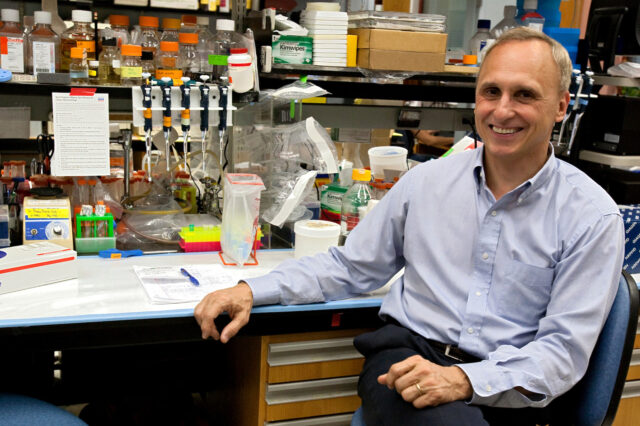Study: UF is world’s top-ranked institution for published gene therapy research

Barry J. Byrne, M.D, Ph.D., a professor and associate chair for research in the UF College of Medicine’s department of pediatrics, is among the world’s most published authors in the field of AAV gene therapy research.
GAINESVILLE, Fla. — The University of Florida is the world’s top contributor to scientific knowledge and literature about a widely used gene therapy technique, according to newly published research.
From 1991 to 2022, UF researchers published 605 articles in scientific journals about the adeno-associated virus vector, or AAV. The therapy uses a harmless, engineered virus to deliver a functioning copy of a defective gene. Gene therapy discoveries at UF and elsewhere have led to breakthrough treatments for hereditary diseases affecting the eye, muscles, blood and heart and launched the field of genetic medicine.
UF researchers accounted for 10% of all published AAV research and their work was cited 36,758 times by other scientists during the 31-year study period. The findings by a group of researchers in China were published in the journal Frontiers in Cellular and Infection Microbiology.
UF is the only institution with three current or former faculty members among the world’s top 10 authors of genetic therapy and AAV publications.
“This is a lifetime achievement for the faculty at UF. It is a testament to what has been contributed by UF to the worldwide knowledge of AAV. Their work has really enabled the whole, current era of genetic medicine,” said Barry J. Byrne, M.D, Ph.D., a professor and associate chair for research in the UF College of Medicine’s department of pediatrics and the Earl and Christy Powell university chair in genetics.
UF’s prominent position is a result of its leaders’ long-term, visionary commitment to gene therapy science and the relentless efforts of its researchers, Byrne said. Earl and Christy Powell have provided long-term support for UF’s Powell Gene Therapy Center and the foundational science was established at UF in 1976 in the laboratory of Dr. Kenneth Berns, former vice president of health affairs and dean of the College of Medicine.
William W. Hauswirth, an emeritus professor of ophthalmology, is the No. 3 most-published author (123 articles; 9,142 citations), the study found. Hauswirth’s discoveries led to the first gene therapy drug to treat Leber congenital amaurosis type 2, an inherited retinal disease.
Hauswirth is joined on the list by the late Mavis Agbandje-McKenna, Ph.D., a biochemistry researcher, who is the world’s sixth-most published author (84 articles; 5,166 citations). She is credited with much of the initial work to define the basic structure and function of AAVs. Berns is responsible for recruiting Agbandje-McKenna and Professor Robert McKenna, Ph.D., who continues their pioneering work in the department of biochemistry and molecular biology. Her work also led to gene therapy techniques for diseases including muscular dystrophies.
With 62 articles and 6,510 citations counted by the journal, Byrne is the world’s No. 9 most-published AAV researcher. His 105 average citations per article is No. 3 in the world. Byrne also has numerous other publications that were not captured in the present study. Also mentioned in the paper is the late Nicholas Muzyczka, Ph.D. (3,173 citations), a professor emeritus and eminent scholar in the department of molecular genetics and microbiology. His work led to AAV becoming the dominant delivery method for gene therapies.
“What is most significant is what the research accomplishes in people, not just papers,” said Jim O’Connell, assistant vice president of commercialization and director of UF Innovate. “Not only have we received more than 250 invention disclosures for AAV and filed nearly 600 patent applications worldwide, but we’ve also signed more than 200 license agreements with companies intent on treating blindness, neuromuscular diseases and more.”
UF’s prominence in gene therapy research stems from what Byrne calls “a strategic investment in a community of dedicated people.” Pioneering AAV work done by UF researchers in the 1980s paved the way for a groundbreaking treatment for a rare and debilitating neuromuscular disease in 2019 and other therapies. More broadly, Byrne said there is a deep commitment to genetic medicine from university and UF Health leaders.
Gene therapy research at UF remains a multidepartment, multicollege effort, Byrne said. Recruitment of other faculty to work on AAV research is underway. Matthew S. Gentry, Ph.D., a professor and chair of the College of Medicine’s department of biochemistry and molecular biology, said the Powell Gene Therapy Center was of his key reasons for joining the university in 2022.
UF has played a historic, transformational role in developing the foundational science of AAV into its current therapeutic form, Gentry said. Those accomplishments include Agbandje-McKenna’s use of cryo-electron microscopy to determine the three-dimensional structure of AAV.
“Along with her collaborator and husband, Rob McKenna, these 3D structures provided road maps of how to manipulate AAV to make it more useful for clinical purposes. Thus, they provided key foundational breakthroughs that everyone around the world has built on,” Gentry said.
About the author
